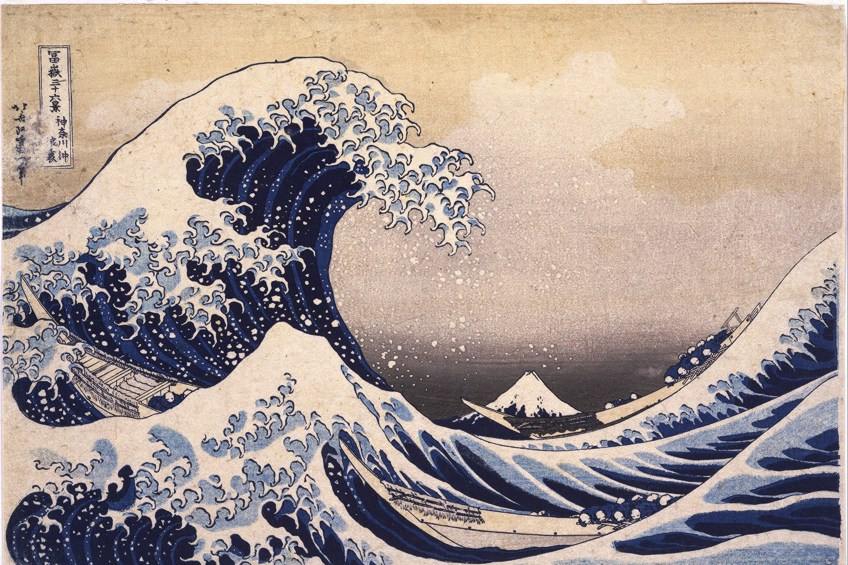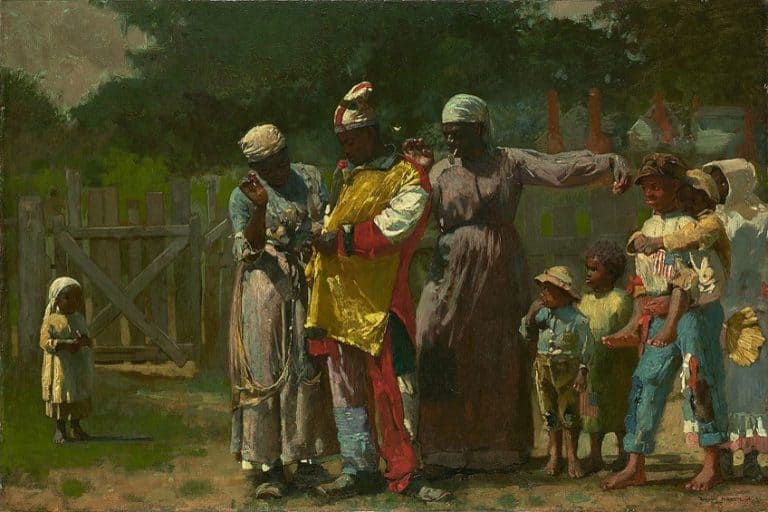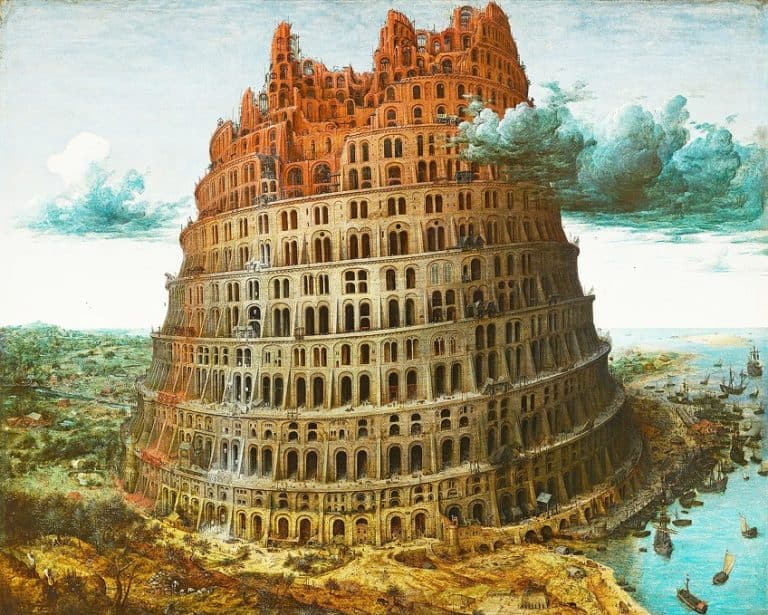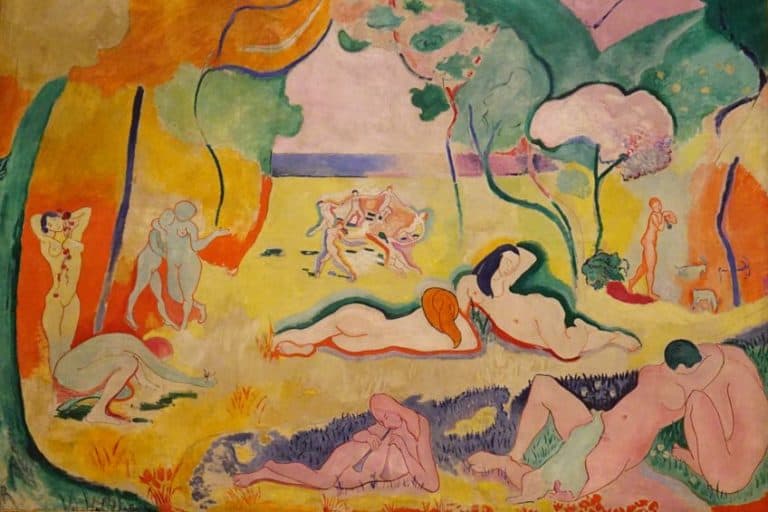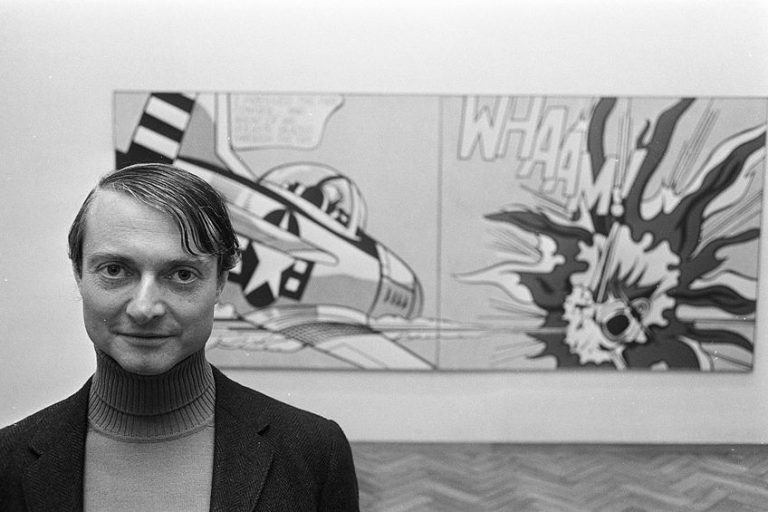“The Great Wave Off Kanagawa” Katsushika Hokusai – An Analysis
No one wants to be at sea and see a great wave about to crash onto them, toppling their boat. This is the moment the Japanese artist, Katsushika Hokusai, has printed in time. Now almost 200 years old, The Great Wave painting is still “making a splash” and there have been thousands of reproductions and prints. We will explore this famous Japanese art example in the article below.
Artist Abstract: Who Was Katsushika Hokusai?
Katsushika Hokusai was a Japanese Ukiyo-e painter, he was born on October 31, 1760, in the Katsushika city in Edo, Japan. Some sources state that his name was Kawamura Tokitaro, however, he apparently changed his name 30 times during his career as an artist. He grew up around artistry and began painting when he was around six years old.
He worked for a woodcarver during his teenage years and studied at Katsukawa Shunshō’s studio where he learned about Ukiyo-e woodblock printing; he was expelled from this school too. He became a well-known artist throughout Japan and Europe. He was married twice and had several children, one of which, named Oi, also became an artist. He apparently produced approximately 30,000 prints during his art career.

The Great Wave off Kanagawa by Katsushika Hokusai In Context
In Japanese, it is titled Kanagawa oki nama ura, which translates to “Under the Wave off Kanagawa”. This is the famous wave painting by Japanese artist Katsushika Hokusai, titled The Great Wave off Kanagawa in English. The painting is also dubbed as just The Great Wave.
Below we will discuss a brief contextual analysis of The Great Wave painting, answering questions like “When was The Great Wave off Kanagawa made?”, which was during the Edo period in Japan, as well as how it fits into the Hokusai paintings and his series of 36 paintings about Mount Fuji.

We will then provide a formal analysis, discussing the wave painting in more detail by looking at the subject matter and various stylistic elements like coloring, perspective, and so forth, all of which characterizes this famous Japanese art style, which is the woodblock print.
| Artist | Katsushika Hokusai (1760 to 1849) |
| Date Painted | c. 1830 to 1832 |
| Medium | Polychrome woodblock print, ink and color on paper |
| Genre | Ukiyo-e woodblock print, Landscape art |
| Period / Movement | Edo period in Japan (1603 – 1867) |
| Dimensions | 25.7 x 37.8 centimeters (around 10 x 14 inches) |
| Series / Versions | Part of the Thirty-Six Views of Mount Fuji series |
| Where Is It Housed? | The Metropolitan Museum of Art (MET), New York, United States |
| What It Is Worth | Estimated worth around millions of dollars |
Contextual Analysis: A Brief Socio-Historical Overview
The Edo period in Japan was between 1603 to around 1867. It was under the rule of the Tokugawa shogunate, which was the form of government during that time, which was based in the capital Edo, now called Tokyo. During this time in Japanese history, there was more stability in economics and society, however, there were also stricter regimes and rules.
Society was also structured into different classes; it started with the emperor and the nobility, then it was the samurai, peasants, craftsmen, and merchants, respectively.
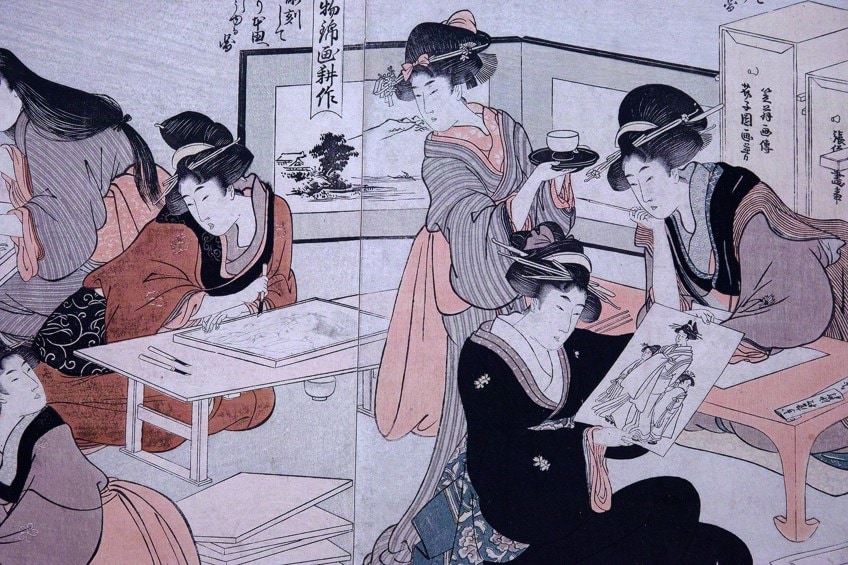
With the increased stability and peace in society, there was also more production of the arts, and it has often been described as a period where people enjoyed the arts and a variety of fields of entertainment. This new exploration of the sensual and sexual was called Ukiyo, meaning “floating world”.
There was a greater sense of taking pleasure in various aspects of life, for example, the Kabuki theatre, Geishas, which were female entertainers and dancers, Sumo wrestling, literature and poetry, Japanese puppet theater (Bunraku), and various aspects related to sex, pleasure, beauty, and love.
What Are the Ukiyo-e Prints?
The Ukiyo-e prints became a genre of art during this period of Japanese history. It was in the form of paintings and woodblock prints that centered around the indulgences and enjoyments from the Ukiyo urban culture. It depicted scenes and figures from all sorts of arts and entertainment.
However, this genre also developed over time and included different subject matters, which included landscapes, nature, and animals. We see the focus on landscapes in the Hokusai paintings.
The different types of subject matter, in more detail, consisted of the Bijin-ga, meaning and referring to images of “beautiful women”. This would often include famous women or courtesans, and those of celebrity status. There was also Shunga, meaning “pictures of Spring”, however, the word “Spring” in this case was another term for sex.
Other types included Yakusha-e, meaning “actor prints” which were of famous actors from the Kabuki theater; Kachō-ga meaning “flower and bird paintings/prints”, which would consist of subject matter from nature.

Ukiyo-e is the Japanese term that translates to “pictures of the floating world” in English. However, this term has another meaning attached to the Buddhist beliefs about the transience of life. It referred to sorrow or sadness about life and the cycle involving death and rebirth. Sources state that uki means “sadness” and yo means “life”.
The term Uki meant “to float” when it was used within the context of the Edo period and all the cultural proliferation. It is easier to understand why the Ukiyo-e prints were so prominent because they depicted not the fleetingness of life and death as the Buddhists believed, but the fleetingness of lifestyles and desires.
Hokusai: The Importance of Waves and Mount Fuji
Hokusai made a wave painting series depicting different views of Mount Fuji. It was called Thirty-Six Views of Mount Fuji (c. 1830 to 1832); in Japanese, this series was called Fugaku sanjurokkei. The Great Wave painting is the first print from this above-mentioned series.
However, this is not Hokusai’s first exploration with waves in his paintings.
In three examples from his earlier paintings, he includes the oceanic wave and its stylistic details, namely Springtime in Enoshima (1797), View of Honmoku off Kanagawa (1803), and Fast Cargo Boat Battling the Waves (1805). In all three of these Hokusai paintings, the wave features in its characteristic curl.

Springtime in Enoshima was believed to have been inspired by the painting A View of Seven-League Beach (1796) by Shiba Kōkan, a Japanese artist who also painted during the Edo period and created Ukiyo-e prints. He used the pseudonym “Suzuki Harushige”, although he also worked under other names.
In Kōkan’s painting, there are two figures to the right on the beach and the ocean wave to the left ebbs onto the shore. We see this wave curl appearing larger in Springtime in Enoshima. Similarly, the wave is also depicted to the left, almost about to crash onto the shore where there are several figures standing.
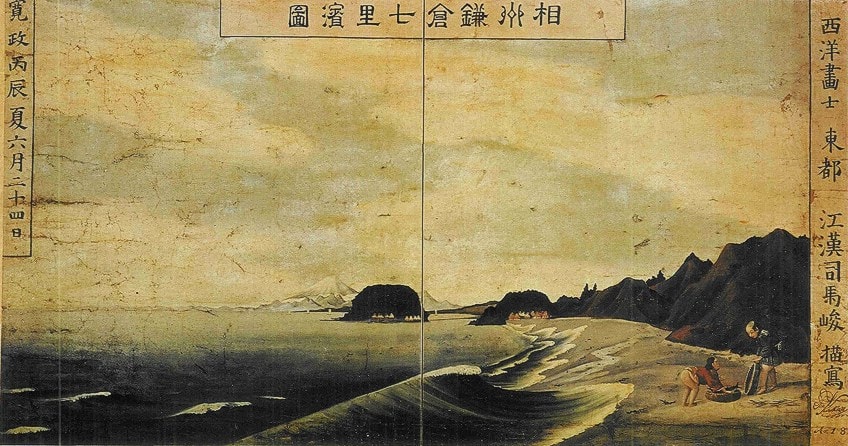
In the latter two Hokusai paintings mentioned above, there are boats on the ocean, and they navigate through the overwhelmingly large waves swaying them about. In View of Honmoku off Kanagawa, there are two boats about to seemingly crash into the large embankment to the left. It is important to note the vantage point, which appears from the side view and almost at eye level.
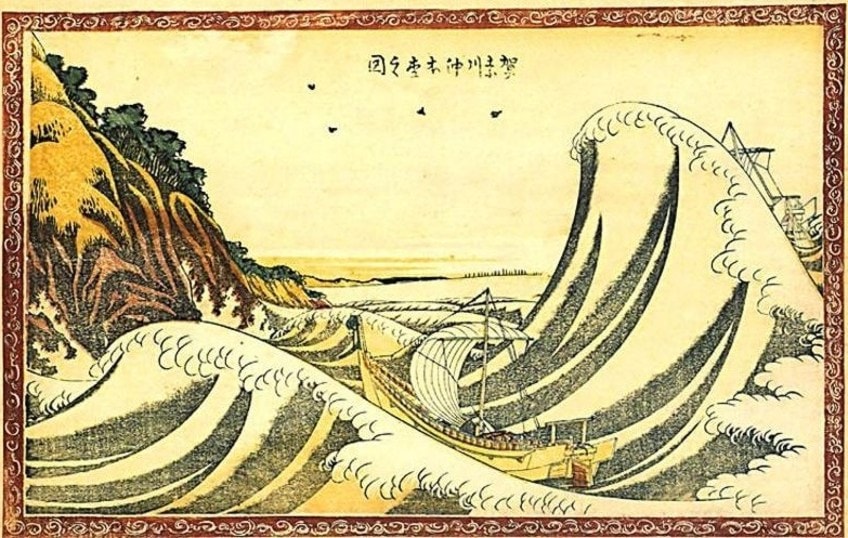
In Fast Cargo Boat Battling the Waves, we see a boat with several figures in it struggling against the sheer steepness of the wave they are on. There are two other visible boats in this composition, all seemingly in their own struggle with the surrounding waves.
The vantage point in this painting is more from an aerial viewpoint, which heightens the dramatic effect.
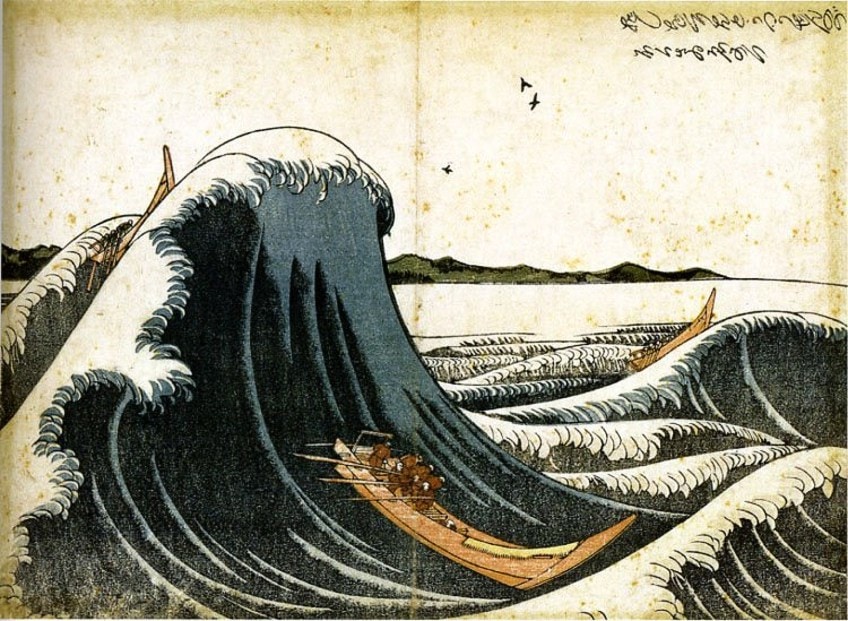
These are important stylistic elements mentioned above, ones which we will discuss as part of The Great Wave off Kanagawa meaning below. We will explore the perspective Hokusai chose to work with as well as how this influenced numerous other artists who lived in Europe at the time.
When looking at Hokusai’s Thirty-Six Views of Mount Fuji series., we will see that he is ultimately focusing on Mount Fuji, giving us various vantage points of the famed Japanese mountain. In The Great Wave off Kanagawa, Katsushika Hokusai makes Mount Fuji visible through the large impending waves.
Mount Fuji is on Japan’s main island, named Honshu. It is Japan’s highest mountain, over 12,000 feet high. It is also an active volcano. Mount Fuji is not just any mountain, as it held a deeper meaning for both Hokusai and the Japanese culture, deeming it a sacred mountain.

Throughout Japan’s history, Mount Fuji was a site for pilgrimages and various deity venerations. It still is a site where people can hike and see its wonders. It has also been the main subject matter for various art forms, including famous Japanese arts that were produced as souvenirs for those who loved the mountain, whether seeking it out for pilgrimages or as a tourist attraction.
From Japan to Europe: Japonism
The Ukiyo-e prints became widespread pieces of art that were also affordable for many in Japan. During the 19th century, the prints came to America and Europe, which was because of opening trade between the West and the East. These famous Japanese art pieces became widespread pieces of art for many European artists we are all familiar with today. This also started the movement, or trend, called Japonism, or Japonisme in French.
Japonism included a wide variety of Japanese arts and designs and was often appropriated from the perspective of the West. It was considered an “exotic” art style.
The Impressionist and Post-Impressionist art movements were among the art styles that drew considerable inspiration from Japanese art, especially the Ukiyo-e woodblock prints. Some examples of artists included the Impressionists like Claude Monet and Edgar Degas; some of the Post-Impressionists included Vincent van Gogh, Paul Gauguin, Henri de Toulouse-Lautrec, and many others.
A famous example includes van Gogh’s painting Bridge in the Rain (After Hiroshige) (1887) painting after the original Ukiyo-e woodblock print by Utagawa Hiroshige called Sudden Shower over Shin-Ōhashi bridge and Atake (c.1856 to 1859).
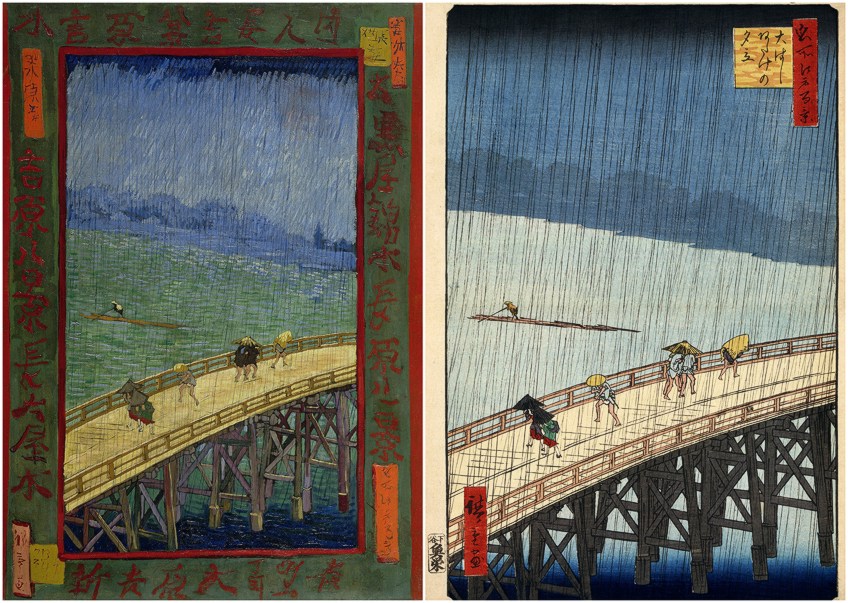
There were also artists from the Art Nouveau style who loved the increasingly famous Japanese art, Gustav Klimt was among them. The art dealer from Germany, Siegfried Bing, was among one of the first to introduce Japanese art in Europe and this, in turn, influenced Klimt’s work too.
He imported various Japanese arts and sold them in Paris.
He was also known to have pioneered the Art Nouveau style in Paris and published Le Japon Artistique (1888 to 1891) journal each month, which explored various Japanese objects and arts. He also exhibited and sold Japanese objets d’art in his gallery Maison d l’Art Nouveau. Bing’s active involvement in procuring Japanese art and objects aided in its dissemination in the West.
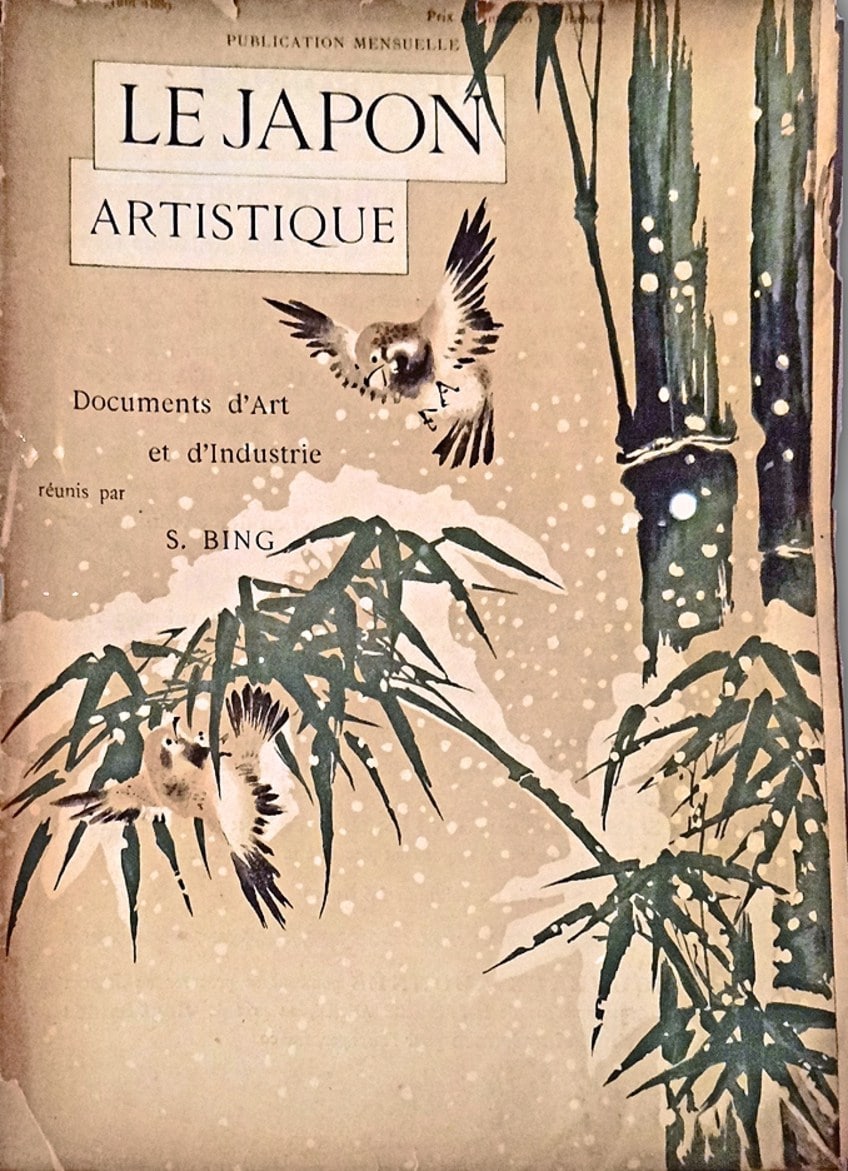
Hokusai’s series Thirty-Six Views of Mount Fuji also influenced other artists like the French Henri Rivière who created his lithograph series called 36 Views of the Eiffel Tower (1902). Hokusai was also an influence on Edgar Degas, who reportedly and endearingly stated that the Japanese artist is “not just one artist among others in the Floating World. He is an island, a continent, a whole world in himself”.
Formal Analysis: A Brief Compositional Overview
Below we look at The Great Wave painting by Hokusai in more detail. Now that we have more understanding of the traditions around this Japanese wave painting and where it came from, we will explain how some of its features correlate with the stylistic characteristics of Ukiyo-e woodblock prints from Japan.
https://www.youtube.com/watch?v=CNxaUf2QHGU
Subject Matter
This famous Japanese art Ukiyo-e print has been viewed via its three main subject matters, namely, the undulating and dominating ocean, the three boats, and the view of Mount Fuji far in the distance. In The Great Wave off Kanagawa Katsushika Hokusai depicts a large, looming, wave coming in from the left-hand side of the composition.
The wave’s size composes most of the left side and fills up what seems to be a gray or creamy colored sky, the wave’s white foamy tips also seemingly double as white clouds in the sky.
The tips of the great wave almost appear like small white claws coming to grab hold of the men in the boats. While this description does not do this print justice, it hints at the enormity and power inherent in the wave and the fragility of the men in the three boats.
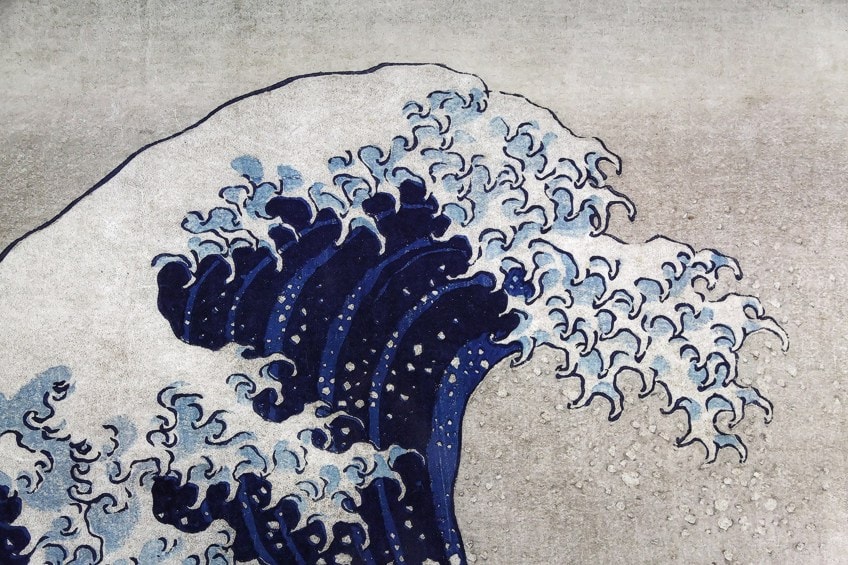
We will also see smaller waves filling up the foreground. There is a sweeping sway of the water from left to right and right to left, giving dynamism and dramatism to the scene. What will happen to the men in the boats? Hokusai captures a moment just before the massive wave will hit.
Let us look at the three boats; there appear to be two in the foreground and one closer to the background.
There are eight rowers in each boat as well as what seems to be two people near the front side of the boat. All the figures are similarly clothed in dark blue, which matches the blue of the water just beneath them. The boats are referred to as oshiokuri-bune boats, which were utilized in Japan for fishing.

HokusaiHokusai, Public domain, via Wikimedia Commons | MIDDLE: Hokusai, Public domain, via Wikimedia Commons | RIGHT: Hokusai, Public domain, via Wikimedia Commons
We will notice that nestled in the distance, opposite our gaze, is the snow-capped Mount Fuji. This also suggests that Hokusai painted the scene during Winter. The mountain has a backdrop of gray skies behind it and around it, which further suggests a storm or that this was painted during the morning light, as some sources suggest. There are more white clouds in the sky as we direct our gaze closer to the foreground.
Some sources also point out that the white tips of the great wave, which are directly above the tip of Mount Fuji, could turn into snow that falls onto the mountain’s peak. This also shows us how Hokusai’s use of perspective offers different interpretations.
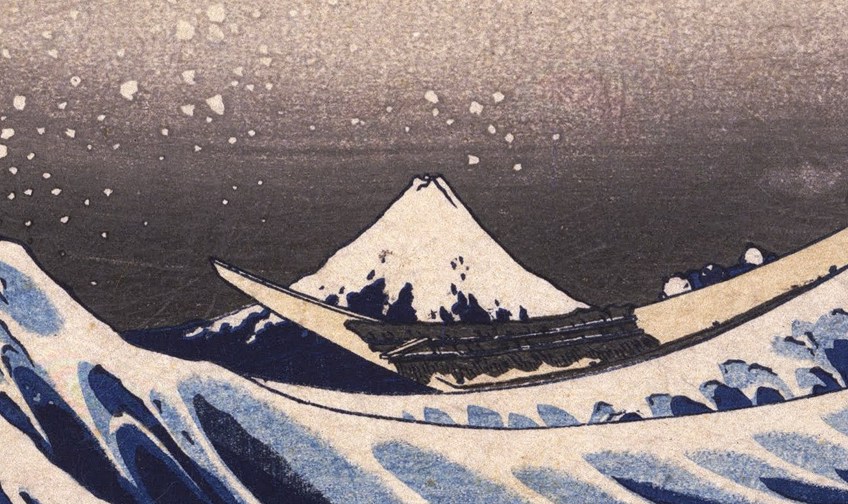
You may also be asking, “Where is The Great Wave off Kanagawa”? The title gives us a clue, being “off Kanagawa”, which is one of Japan’s prefectures around the region called Kantō in Honshu, which, as we mentioned earlier, is the main island of Japan. This question can also have a double meaning; in case you wondered where the print is now, it is housed at the Metropolitan Museum of Art in New York City.
To the left-hand border of the print, there are two vertical signatures or inscriptions in traditional Japanese script, possibly Kanji.
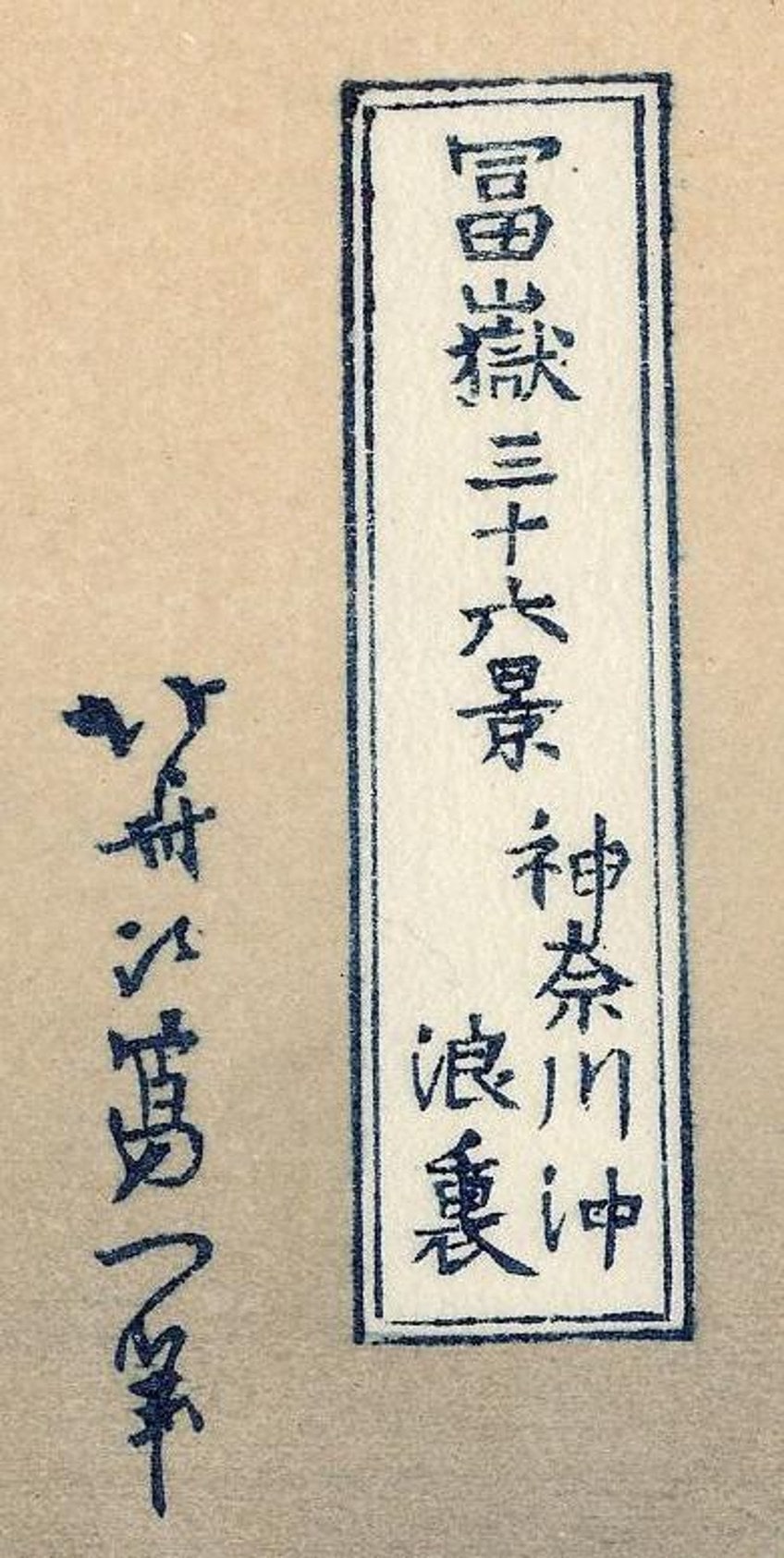
The inscription to the far-left states Hokusai’s name and has been translated as, “Hokusai aratame litsu hitsu, meaning “From the brush of Hokusai, changing his name to litsu”. Apparently, Hokusai frequently also changed his name, which would explain why the inscription states that he is changing his name to “litsu”.
The inscription with the surrounding border is the title of the print. It states Fugaku Sanjūrokkei / Kanagawa oki / nami ura, meaning “Thirty-six Views of Mount Fuji / Offshore from Kanagawa / Beneath the wave”.
Color
In The Great Wave off Kanagawa Katsushika Hokusai utilized various shades of blues. This has been a notable feature of this famous Japanese art woodblock print, but also of the overall series, Thirty-six Views of Mount Fuji. There was a specific color, called Prussian blue, that Hokusai reportedly utilized in his prints. This was reportedly discovered after scientific studies were done on Hokusai’s print.
Prussian blue was also called “Berlin blue” and was apparently discovered by the Berlin pigment maker, Johann Jacob Diesbach in 1706.
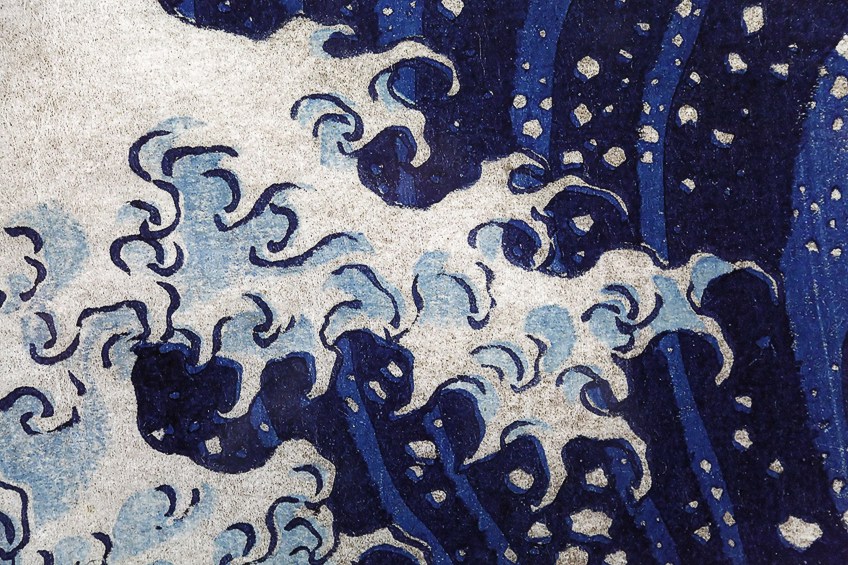
Prussian blue was also imported from Europe and reportedly there was a great demand for it when Hokusai created his famous wave painting. This was a synthetic blue that lasted longer and did not fade as quickly.
Perspective and Scale
If we look at the perspective and scale in The Great Wave painting, we will find that it points us to a lot of the characteristics related to perspective and how Japanese artists utilized space in their Ukiyo-e prints in general. Hokusai presents us with a scene that appears from a semi-aerial vantage point. We, the viewers, are situated at an unknown viewpoint that seems to be slightly elevated giving us this bird’s eye view.
However, simultaneously, Hokusai also places us at more of a level vantage point, almost as if we too are on a boat viewing the impending crash from the great wave. We also see Mount Fuji directly opposite our gaze.
The perspective is further highlighted by how Hokusai utilized line and movement. Our gaze is continuously pulled by the current of curving motions created from the waves in front of us. And as our gaze swirls, we eventually arrive at the smaller depiction of Mount Fuji in the distance. This creates depth within the composition, giving it that dynamic three-dimensional quality. It also indicates Hokusai’s exploration of contrasting spatial aspects of something closely viewed and far away.
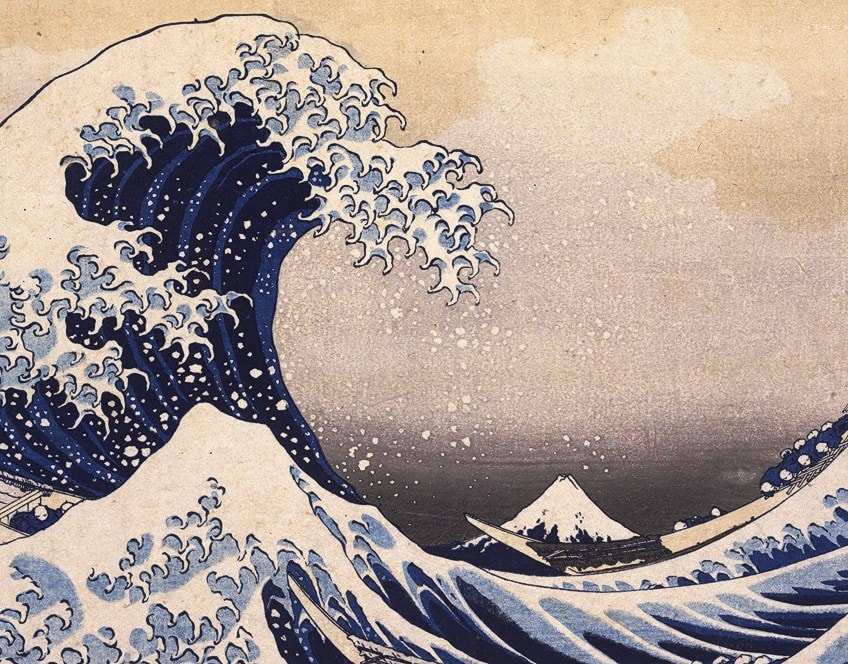
It is also important to note that Hokusai was also influenced by Dutch and French copper engravings, which inspired his techniques to include European styles of linear perspective.
We also see how Hokusai plays on different geometric shapes and lines in The Great Wave painting, from the beautiful curving wave in the foreground to the smaller triangular shape of Mount Fuji in the background. There is a strong diagonal rhythm from the way the waves are painted, but also a horizontal rhythm from the boats in the water. The boats, although playing on the horizontal, equally play on and echo the curves from the water and waves.
“Just Another Five More Years”
This is reportedly what Katsushika Hokusai said on his deathbed; he died in 1849. He wanted more years as an artist and is widely quoted by many sources as saying, “If only heaven will give me just another ten years…Just another five more years, then I could become a real painter”.
Whatever Hokusai may have believed about his abilities as an artist, whether he felt he was not good enough or needed more practice, he certainly imprinted his artworks in the memories of many artists when he was alive and after his death to the present time.
Take a look at our The Great Wave off Kanagawa webstory here!
Frequently Asked Questions
When Was The Great Wave off Kanagawa Made?
The Great Wave off Kanagawa was painted during the Edo period in Japan, which spanned between the 1600s to 1800s. It is estimated to have been made and published around 1831. It was a part of Hokusai’s series of paintings titled Thirty-Six Views of Mount Fuji (c. 1830 to 1833).
Where Is The Great Wave off Kanagawa?
The Great Wave off Kanagawa print is housed at the Metropolitan Museum of Art (MET) in New York City, United States. Other reproductions and prints are housed at different institutions worldwide.
What Is The Great Wave off Kanagawa Meaning?
When we look at The Great Wave off Kanagawa meaning and inherent symbolism it could point to the idea of nature and man and these contrasting forces. The men in the boats seem to be in a losing battle against the sheer force and power we see in the magnitude of the wave about to crash over them.
Alicia du Plessis is a multidisciplinary writer. She completed her Bachelor of Arts degree, majoring in Art History and Classical Civilization, as well as two Honors, namely, in Art History and Education and Development, at the University of KwaZulu-Natal, South Africa. For her main Honors project in Art History, she explored perceptions of the San Bushmen’s identity and the concept of the “Other”. She has also looked at the use of photography in art and how it has been used to portray people’s lives.
Alicia’s other areas of interest in Art History include the process of writing about Art History and how to analyze paintings. Some of her favorite art movements include Impressionism and German Expressionism. She is yet to complete her Masters in Art History (she would like to do this abroad in Europe) having given it some time to first develop more professional experience with the interest to one day lecture it too.
Alicia has been working for artincontext.com since 2021 as an author and art history expert. She has specialized in painting analysis and is covering most of our painting analysis.
Learn more about Alicia du Plessis and the Art in Context Team.
Cite this Article
Alicia, du Plessis, ““The Great Wave Off Kanagawa” Katsushika Hokusai – An Analysis.” Art in Context. January 2, 2022. URL: https://artincontext.org/the-great-wave-off-kanagawa-katsushika-hokusai/
du Plessis, A. (2022, 2 January). “The Great Wave Off Kanagawa” Katsushika Hokusai – An Analysis. Art in Context. https://artincontext.org/the-great-wave-off-kanagawa-katsushika-hokusai/
du Plessis, Alicia. ““The Great Wave Off Kanagawa” Katsushika Hokusai – An Analysis.” Art in Context, January 2, 2022. https://artincontext.org/the-great-wave-off-kanagawa-katsushika-hokusai/.


